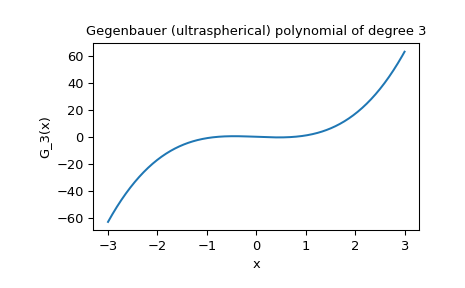scipy.special.gegenbauer¶
-
scipy.special.gegenbauer(n, alpha, monic=False)[source]¶ Gegenbauer (ultraspherical) polynomial.
Defined to be the solution of
\[(1 - x^2)\frac{d^2}{dx^2}C_n^{(\alpha)} - (2\alpha + 1)x\frac{d}{dx}C_n^{(\alpha)} + n(n + 2\alpha)C_n^{(\alpha)} = 0\]for \(\alpha > -1/2\); \(C_n^{(\alpha)}\) is a polynomial of degree \(n\).
- Parameters
- nint
Degree of the polynomial.
- alphafloat
Parameter, must be greater than -0.5.
- monicbool, optional
If True, scale the leading coefficient to be 1. Default is False.
- Returns
- Corthopoly1d
Gegenbauer polynomial.
Notes
The polynomials \(C_n^{(\alpha)}\) are orthogonal over \([-1,1]\) with weight function \((1 - x^2)^{(\alpha - 1/2)}\).
Examples
>>> from scipy import special >>> import matplotlib.pyplot as plt
We can initialize a variable
pas a Gegenbauer polynomial using thegegenbauerfunction and evaluate at a pointx = 1.>>> p = special.gegenbauer(3, 0.5, monic=False) >>> p poly1d([ 2.5, 0. , -1.5, 0. ]) >>> p(1) 1.0
To evaluate
pat various pointsxin the interval(-3, 3), simply pass an arrayxtopas follows:>>> x = np.linspace(-3, 3, 400) >>> y = p(x)
We can then visualize
x, yusingmatplotlib.pyplot.>>> fig, ax = plt.subplots() >>> ax.plot(x, y) >>> ax.set_title("Gegenbauer (ultraspherical) polynomial of degree 3") >>> ax.set_xlabel("x") >>> ax.set_ylabel("G_3(x)") >>> plt.show()
